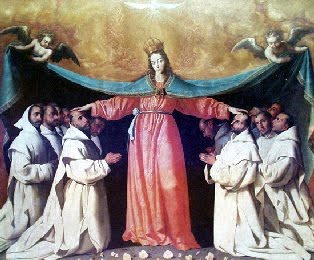 “One evening as I entered my cell, I saw the Lord Jesus exposed in the Monstrance under the open sky, as it seemed. At the Feet of Jesus I saw my Confessor, and behind him a great number of the highest ranking ecclesiastics, clothed in vestments the like of which I had never seen except in this vision; and behind them, groups of religious from various Orders; and further still I saw enormous crowds of people, which extended far beyond my vision. I saw the two rays coming out from the Host, as in the image, closely united but not intermingled; and they passed through the hands of my Confessor, and then through the hands of the clergy and from their hands to the people, and then they returned to the Host.”
“One evening as I entered my cell, I saw the Lord Jesus exposed in the Monstrance under the open sky, as it seemed. At the Feet of Jesus I saw my Confessor, and behind him a great number of the highest ranking ecclesiastics, clothed in vestments the like of which I had never seen except in this vision; and behind them, groups of religious from various Orders; and further still I saw enormous crowds of people, which extended far beyond my vision. I saw the two rays coming out from the Host, as in the image, closely united but not intermingled; and they passed through the hands of my Confessor, and then through the hands of the clergy and from their hands to the people, and then they returned to the Host.”These words are from the Diary of Saint Maria Faustina Kowalska. It would seem to be a marvelous vision of Christ’s Church in Eucharistic Adoration.
Later she wrote: “When I was in church waiting for Confession, I saw the same rays issuing from the Monstrance and spreading throughout the church. This lasted all through the service.” This “service” which she mentions was Eucharistic Adoration followed by Benediction. Saint Faustina continued: “After the Benediction, the rays shone out to both sides and returned again to the Monstrance. Their appearance was bright and transparent like crystal.”
These “rays” were explained by our Lord to Saint Faustina: “The two rays denote Blood and Water. The pale ray stands for the Water which makes souls righteous.” This of course is the Sacrament of Baptism. Our Lord continued: “The red ray stands for the Blood which is the life of souls.” This is the Sacrament of the Eucharist.
Most fascinating about these rays is Saint Faustina’s description of them appearing “like crystal.” Saint John the Evangelist’s vision would seem to concur: “And he showed me a river of water of life, clear as crystal, proceeding from the Throne of God, and of the Lamb” (Revelation 22:1). This would appear to be synonymous with the pale ray of Water. Saint John the Evangelist also wrote: “He showed me the holy city of Jerusalem, coming down out of heaven from God, having the glory of God, and the light thereof was like to a precious stone, as to the jasper stone even as crystal” (Revelation 21:10-11). The color of jasper is red, which is harmonious with the Blood of Christ or the Eucharist.
The mercy of Jesus, therefore, flows from His Eucharistic Heart, but also His mercy is to be received by means of the holy city of Jerusalem, signifying the Church, the New Jerusalem. And once again referring to our Savior’s Eucharistic Heart, Saint Faustina also saw these rays during Vespers with a Eucharistic procession for the Sacred Heart of Jesus.
Jesus spoke to Saint Faustina about three o’clock being the hour of mercy. One of the options that our Lord suggests at this “hour of grace for the whole world” is to be in the chapel adoring the Blessed Sacrament.
The rays of mercy flow from the Heart of Jesus in Eucharistic Adoration. Shouldn’t we adore Jesus in the Blessed Sacrament as often as possible? Jesus said to Saint Faustina: “These rays shield souls from the wrath of My Father. Happy is the one who will dwell in their shelter.”











